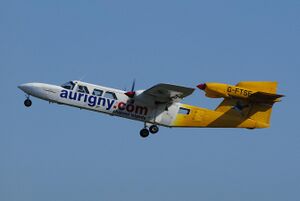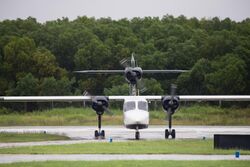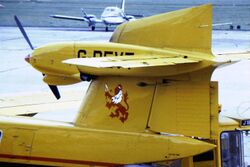Engineering:Britten-Norman Trislander
The Britten-Norman Trislander (more formally designated the BN-2A Mk III Trislander) is a three-engined piston-powered utility aircraft designed and produced by the British aircraft manufacturer Britten-Norman.
The Trislander was designed in the late 1960s as an expanded derivative of the company's Islander, a twin-engined commercial aircraft that had proved to be a commercial success. In comparison to its predecessor, it had a larger carrying capacity, being capable of seating up to 18 passengers, and could also perform STOL operations when required.[1] On 11 September 1970, the prototype Trislander performed its maiden flight; the type entered revenue service less than a year later.
Being marketed primarily as a feederliner and mostly sold to civilian operators, the Trislander was primarily manufactured at the company's facility on the Isle of Wight between 1970 and 1982. Later on, the Trislander was also produced in Romania, and delivered via Belgium to Britain for certification.[2] Several different commuter airlines have operated the Trislander in scheduled passenger services, the largest being the Guernsey-based operator Aurigny, which flew the type for over 40 years. Despite plans to produce the Trislander at the American manufacturer International Aviation Corporation (IAC) as the Tri-Commutair, these did not come to fruition.
Design and development
During the 1960s, the British aircraft manufacturer Britten-Norman, founded by John Britten and Desmond Norman, had designed and commenced production of the Islander, a twin-engined commercial aircraft that quickly proved itself to be a commercial success.[3] Being keen to capitalise on the Islander, the company's management opted to pursue development of a larger aircraft that would be derived from its predecessor as to benefit from commonalities and to lower development costs. In 1968, the company flew a stretched variant of the aircraft, known as the BN-2E Islander Super, however, this model was never pursued through to certification in favour of a more radical alternative design - the Trislander.[3]
Seeking to give the aircraft a considerably larger carrying capacity, the Islander's fuselage was stretched and strengthened considerably for the Trislander, a measure that necessitated various configuration changes The most visually apparent of these was the addition of a third engine located on the fuselage centre line atop an elongated tailfin.[3] A fixed tricycle landing gear arrangement was also adopted. While possessing an unorthodox appearance, the arrangement proved practical; in terms of construction, the Trilander was similar enough to the Islander that the two aircraft shared the same final assembly line.[3]
The prototype of the Trislander was constructed from the original second prototype of the Islander; it performed its maiden flight on 11 September 1970.[4] Confidence in the type was such that it appeared at the Farnborough Air Show that same day.[3] Britten-Norman opted to principally promote the Trislander to prospective operators as a feederliner; foreseen secondary roles included its potential use by military air services as well.[3]
In terms of its flying characteristics, the Trislander possesses exceptional low speed handling characteristics, extended endurance, increased payload, and a relatively low noise signature. Capable of taking off from a 150 metres (492 ft) long landing strip, the Trislander can readily operate from unprepared surfaces. It was also promoted for its economical operating costs. Some variants came equipped with auto-feathering propellers and auxiliary rocket-assisted takeoff (RATO) apparatus.[3]
Operational history
During July 1971, the Trislander entered service with the Guernsey-based Aurigny, one month after the deliveries of the type had commenced.[5] Aurigny would be the largest operator of the type, operating 16 Trislanders at its peak.[5] In May 2017, Aurigny opted to withdraw all of its Trislanders,[6][7] the type having been replaced by newer Dornier 228s.[8] One of the ex-Aurigny Trislanders has been preserved and placed on display at the Imperial War Museum Duxford in the UK while another aircraft is displayed at Oaty & Joey's play barn at Oatlands in Guernsey.[9][10]
Following the acquisition of Britten-Norman by the Fairey Aviation Group in August 1972 and the formation of the Fairey Britten-Norman company; the majority of manufacturing activity for both the Islander and Trislander was transferred to its Avions Fairey factory in Gosselies, Belgium.[11][12] All production activity of the type in Britain ceased in 1982, by which point 73 Trilanders had been delivered while a further seven aircraft were complete but unsold; that same year, Pilatus Britten Norman sold a manufacturing license to the American manufacturer International Aviation Corporation (IAC). IAC had planned to produce an initial batch of 12 Trislanders (which were to be marketed under the name Tri-Commutairs) from parts kits supplied by Britten-Norman before undertaking full production,[13] however, these plans ultimately came to nothing.[14]
Into the 2020s, companies have continued to operate the Trislander; a number have been made available for private entities to hire.[15]
Variants
- BN-2A Mk III-1
- First production version, with short nose.
- BN-2A Mk III-2
- Lengthened nose and higher operating weight.
- BN-2A Mk III-3
- Variant certified for operation in the United States .
- BN-2A Mk III-4
- III-2 fitted with 350 lb (160 kg) rocket-assisted takeoff equipment.
- BN-2A Mk III-5
- III-2 with sound-proofed cabin, modernised cockpit/interior and new engines (proposed, unbuilt as yet).
- Trislander M
- Proposed military version, not built.
Operators
Current operators
 Anguilla
Anguilla
- Anguilla Air Services[16]
 Guyana
Guyana
- Roraima Airways[17]
 Puerto Rico
Puerto Rico
- Air Flamenco
- Vieques Air Link
Former operators
 Antigua and Barbuda
Antigua and Barbuda
- LIAT[18]
 Australia
Australia
- Aerodata
- Air Queensland
 Bahamas
Bahamas
- Lucaya Air
 Canada
Canada
- Burrard Air Ltd.
- Questor Surveys Ltd.
 Colombia
Colombia
- Tavina
 Costa Rica
Costa Rica
- Travel Air
 Botswana
Botswana
- Botswana Defence Force Air Wing
 Cayman Islands
Cayman Islands
- Cayman Airways
 Fiji
Fiji
- Air Pacific
- Air Fiji
 Guernsey
Guernsey
- Aurigny[19]
 Isle of Man
Isle of Man
- Manx Airlines
 Jamaica
Jamaica
- Trans-Jamaican Airlines
 Jersey
Jersey
- Blue Islands[20]
 Liberia
Liberia
- Air Liberia
 Philippines
Philippines
- PinoyAir
 New Zealand
New Zealand
- Barrier Air[21]
 Sierra Leone
Sierra Leone
- Sierra Leone Airways
 Taiwan
Taiwan
- Taiwan Airways
 Turks and Caicos Islands
Turks and Caicos Islands
- Turks & Caicos Airways
 United Kingdom
United Kingdom
- Air Ecosse
- Air Sarnia
- Emerald Airways
- Lydd Air[22]
- Loganair[23]
- National Airways
- Rockhopper Aero
- Sky Trek
- Willow Air
- XP - Express Parcel Systems
 United States
United States
- Air Flamenco
- Air St. Thomas
- Air South
- Cen-Tex Airlines
- Channel Islands Aviation (based at the Oxnard Airport)
- Slocum Airlines
- Stol Air Commuter (renamed WestAir Commuter Airlines)
- Tri Air
- Wings Airways
 Vanuatu
Vanuatu
- Vanair
- Unity-Airlines
 Venezuela
Venezuela
- Chapi Air
- Sol America
Accidents and incidents
On 5 July 2009, a Trislander belonging to Great Barrier Airlines (now Barrier Air) lost its starboard side prop six minutes into a flight from Great Barrier Island, New Zealand, to Auckland. The prop sheared off and impacted the fuselage, prompting a successful emergency landing. While there were injuries, no deaths were reported. The accident was caused by undetected corrosion of the propeller flange which led to its eventual failure.[24]
On 15 December 2008, a Trislander operated by LAP in Puerto Rico crashed into the sea somewhere near the Turks and Caicos, shortly after a distress call. A spokesman for the Asociación Nacional de Pilotos reported that the pilot had his licence suspended in October 2006.[25]
On 8 October 1977, ZS-JYF, operated by Southern Aviation, impacted the ground while attempting a stall turn during an air display at Lanseria in South Africa . Despite sustaining severe damage (it was damaged beyond repair) the aircraft performed an emergency landing and neither occupant was injured.[26]
Specifications (BN-2A Mk III-2)
Data from Jane's All The World's Aircraft 1976–77[4]
General characteristics
- Crew: 1 or 2
- Capacity: 16 or 17 passengers
- Length: 49 ft 3 in (15.01 m)
- Wingspan: 53 ft 0 in (16.15 m)
- Height: 14 ft 2 in (4.32 m)
- Wing area: 337.0 sq ft (31.31 m2)
- Aspect ratio: 7.95:1
- Airfoil: NACA 23012
- Empty weight: 5,842 lb (2,650 kg)
- Max takeoff weight: 10,000 lb (4,536 kg)
- Fuel capacity: 154 imp gal (185 US gal; 700 L)
- Powerplant: 3 × Lycoming O-540-E4C5 air-cooled flat-six piston engines, 260 hp (190 kW) each
- Propellers: 2-bladed Hartzell HC-C2YK-2G/C8477-4 constant speed propellers
Performance
- Maximum speed: 180 mph (290 km/h, 160 kn) at sea level
- Cruise speed: 155 mph (249 km/h, 135 kn) (59% power) at 13,000 ft (4,000 m)
- Range: 1,000 mi (1,600 km, 870 nmi)
- Service ceiling: 13,160 ft (4,010 m)
- Rate of climb: 980 ft/min (5.0 m/s)
- Take off run to 50 ft (15 m): 1,950 feet (590 m)
- Landing run from 50 ft (15 m): 1,445 ft (440 m)
See also
Related development
- Britten-Norman Islander
Aircraft of comparable role, configuration and era
References
- ↑ "Type Certificate No. EASA.A.389 for BN2A Mark III Trislander". easa.europa.eu. 23 November 2020. https://www.easa.europa.eu/en/document-library/type-certificates/aircraft-cs-25-cs-22-cs-23-cs-vla-cs-lsa/easaa389.
- ↑ "Home". BN Historians. http://www.bnhistorians.co.uk.
- ↑ 3.0 3.1 3.2 3.3 3.4 3.5 3.6 Goold, Ian (16 October 2006). "Britten-Norman Islander celebrates 40th anniversary". AIN Online. http://www.ainonline.com/aviation-news/aviation-international-news/2006-10-16/britten-norman-islander-celebrates-40th-anniversary.
- ↑ 4.0 4.1 Taylor, John W. R. Jane's All The World's Aircraft 1976–77. London: Jane's Yearbooks, 1976. ISBN:0-354-00538-3, pp. 176-177.
- ↑ 5.0 5.1 Cunliffe, Charles (October 2015). "Trislander Sunset". Air International 89 (4): 123. ISSN 0306-5634.
- ↑ "Aurigny Trislander takes final commercial flight". 31 May 2017. http://www.itv.com/news/channel/2017-05-31/aurigny-trislander-takes-final-commercial-flight/.
- ↑ "Trislander for Solent Sky". Aeroplane 45 (5): 10. May 2017. ISSN 0143-7240.
- ↑ "Aurigny Dornier 'should' arrive in Alderney in October". BBC News. 30 September 2014. https://www.bbc.co.uk/news/world-europe-guernsey-29423354.
- ↑ "Imperial War Museum Duxford". https://www.iwm.org.uk/visits/iwm-duxford.
- ↑ Baudains, Nigel (2 January 2019). "Joey's new home attracts crowds despite 'soft launch'". Guernsey Press. https://guernseypress.com/news/2019/01/02/joeys-new-home-attracts-crowds-despite-soft-launch/.
- ↑ "Avions Fairey Gosselies & Sonaca: a Tips of genie". Belgian Aircraft History Association. http://www.baha.be/Webpages/Navigator/Belgian_Aviation_History/Industry/Sonaca.htm.
- ↑ Fricker, John (September 1977). "Past and Present". Flying 101 (3): 271. ISSN 0015-4806. https://books.google.com/books?id=SOUUuRXEFmoC&pg=PA271.
- ↑ Taylor, John W. R. (1982). Jane's All The World's Aircraft 1982–83. London, UK: Jane's Yearbooks. pp. 268, 392. ISBN 0-7106-0748-2.
- ↑ Trevett, John (11 May 1985). "Commuter Aircraft Directory: International Aviation Corp (USA)". Flight International. p. 47. https://www.flightglobal.com/pdfarchive/view/1985/1985%20-%201425.html.
- ↑ "BN2A Trislander". privatefly.com. https://www.privatefly.com/private-jets/turboprop-hire/BN2A-Trislander.html.
- ↑ "Anguilla Air Services adds maiden Trislander". ch-aviation.com. https://www.ch-aviation.com/portal/news/78194-anguilla-air-services-adds-maiden-trislander.
- ↑ "Roraima unveils Britten Norman Trislander". guyanachronicle.com. 26 April 2016. http://guyanachronicle.com/roraima-unveils-britten-norman-trislander/.
- ↑ "LIAT: the caribbean airline". https://www.liat.com/.
- ↑ "aurigny.com – channel islands". http://www.aurigny.com/.
- ↑ "Aircraft fleet, Blue Islands aircraft fleet, Blue Islands ATR aircraft - Blue Islands". https://www.blueislands.com/flying-with-us/aircraft-fleet.
- ↑ "Barrier Air. Fleet". https://www.barrierair.kiwi/about-us/fleet/.
- ↑ "Our fleet". lyddair.com. http://www.lyddair.com/-our-fleet.html.
- ↑ "Loganair :: Aircraft – Loganair". http://www.loganair.co.uk/loganair/aircraft.
- ↑ "Investigation 09-004 Report 09-004, Britten Norman BN2A-Mk III Trislander, ZK-LOU loss of engine propeller assembly, near Claris, Great Barrier Island, 5 July 2009". New Zealand Transport Accident Investigation Commission (TAIC). http://www.taic.org.nz/ReportsandSafetyRecs/AviationReports/tabid/78/ctl/Detail/mid/482/InvNumber/2009-004/Page/0/language/en-US/Default.aspx?SkinSrc=.
- ↑ "Accident description". 16 December 2008. http://aviation-safety.net/database/record.php?id=20081215-0.
- ↑ Ranter, Harro. "ASN Aircraft accident Britten-Norman BN-2A Trislander Mk.III-2 ZS-JYF Lanseria Airport (HLA)". https://aviation-safety.net/database/record.php?id=19771008-1.
Further reading
| Wikimedia Commons has media related to: |
- US patent 3807665, published 30 April 1974, assigned to Britten Norman
- The Illustrated Encyclopedia of Aircraft (Part Work 1982–1985). London: Orbis Publishing, 1985.
- Stroud, John. "Post War Propliners: Islander and Trislander". Aeroplane Monthly. Vol. 22, No. 8. August 1994. pp. 44–49. ISSN 0143-7240.
- "Britten-Norman BN-2A Mk.3 Trislander". airliners.net. http://www.airliners.net/aircraft-data/stats.main?id=134.
 |









